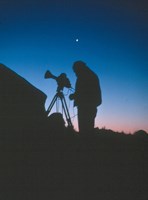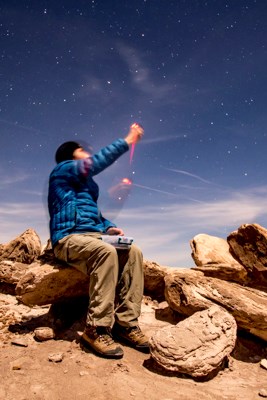
Over half a million people visit Petrified Forest National Park each year, but only a tiny fraction of those visitors get to see the park’s fabulous night skies. Due to the park hours, the gates are closed from about dusk until around dawn. Only the few people who backpack into the wilderness area to camp overnight view the amazingly clear, dark skies. In dry regions, the air has little humidity to affect visibility. The park is also located over 200 miles from any large cities. The stars are huge and the path of the Milky Way particularly clear in our skies. Several times a year, the park offers evening programs that offer opportunities to see the night skies. Even in this relatively remote area, light pollution is a factor. Nearby towns do allow light to seep above the horizon. Communities to the south create a faint glow over the White Mountains. Many national parks are becoming affected by light pollution. The National Park Service has been working with the International Dark-Sky Association and other institutions to protect this incredible but often-overlooked resource. 
NPSPHOTO/Jake Holgerson A Sanctuary for the StarsPetrified Forest has recognized that a naturally dark sky is an important resource worth preserving. With the help of the International Dark Sky Association and the National Park Service (NPS) Natural Sounds and Night Skies Division, we are actively taking steps to achieve International Dark Sky Park status. To do this, it is important to find out just how dark it is in the park at night. The Science of the DarkSky Quality Measurement Surveys (SQM) are a long term management plan to identify and measure night sky quality. They are performed by park staff at different locations throughout the park to create a grid showing the darkest areas within park boundaries. SQM surveys are performed once a year at a minimum and are supplemental to the more in-depth surveys implemented by the NPS Natural Sounds and Night Skies Division. These surveys require a clear sky after astronomical twilight and no moon. There are three methods recommended by the International Dark Sky Association. At least two of these methods are conducted for each site. 
NPSPHOTO / Jake Holgerson Two Unihedron Sky Quality Meters have been purchased by the park to take measurements of sky brightness. These meters require areas that have no immediate light sources directly overhead. Once these devices have reached environmental temperature, three readings are executed per device. After the readings are taken and recorded, they are averaged for each device. Method 2: Bortle Scale Interpretation Created by John E. Bortle, the Bortle Scale Interpretation uses assisted and naked-eye observations to determine how light pollution effects on night sky phenomenon. A flow chart provides different objects and phenomenon in the sky that can be observed at different times of the year. The scale has nine different classes, Class 9 being the lowest quality and Class 1 being the highest. For instance, if you cannot see all seven of the main stars of Ursa Minor, you have Bortle Class 9. If M33 and/or Sagittarius and Scorpius regions of the Milky Way cast a shadow, you have a Bortle Class 1. Assisted observations are performed with binoculars. Method 3: Photographic Evidence This method is used as a supplement Bortle Scale Interpretations to document specific night sky phenomenon. This is done by photographing the Milky Way, the Zodiacal light, and other celestial objects. Included with the photographs is camera information and photograph metadata. The Bortle Scale and photographic evidence are less quantitative methods compared to using a Unihedron Sky Quality Meter, but used together provides stronger data points. 
NPSPHOTO Understanding the UnihedronWhat do the numbers all mean? Simply put, the higher the number, the darker the environment. Normal night time viewing falls between 16 - 21 SQM. Some of the darkest areas in the world, with absolutely no light pollution, get a SQM rating at 24. By understanding which areas are most impacted by light pollution, we can adapt our lighting fixtures and mitigate artifical sky glow from within the park. We can also identify which locations are ideal for night time viewing.For more in-depth information on how the National Park Service manages nightscapes, check out the NPS Natural Sounds and Night Skies |
Last updated: September 8, 2019
